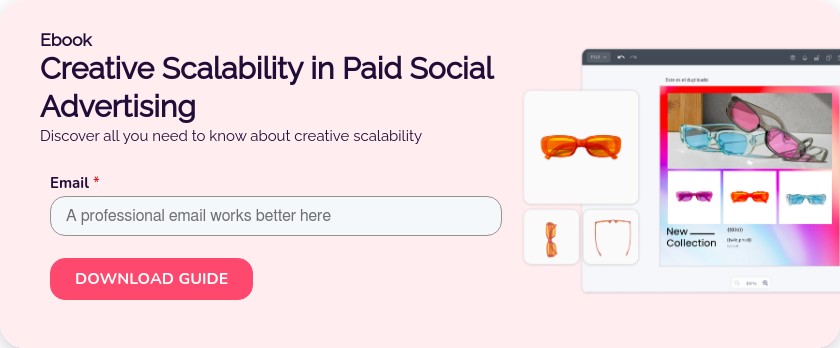Meta AI: What It Is, how it works & creative tools to boost your social media content
Meta has done it again. It placed AI at the center of its universe—and not just to summarize your chat with your best friend. We're talking about...
Plan, activate and control media to hit targets with precision.
Turn data into smart decisions with advanced analytics and modeling.
Efficiency, governance and scale for agencies and teams.
![[Ebook] SEO + AI: eBook to Master AI Overviews and GEO](https://www.adsmurai.com/hubfs/MKT%20-%202025/WEB/Resources%20-%20Banners/HeaderEN_Ebook_SEO+AI.png)
[Ebook] SEO + AI: eBook to Master AI Overviews and GEO
Learn how to structure and distribute your content so generative models can understand it, trust it, and reuse it in their answers. A practical guide to compete and appear in AI Overviews and AI-powered assistants.
Discover more
Want to test more creatives in your campaigns? Of course you do. In the world of Paid Social, scaling campaigns isn’t just about throwing more money into the budget. It’s mainly about listening to audiences, testing, adapting, and repeating... and for that, you need a creative arsenal that doesn’t run dry by the third scroll.
This is where creative scalability comes into play. And we’re not just talking about producing lots of ads—but doing it smartly (and backed by data), with automation, and without asking your creative team to work miracles.
At Adsmurai, we’ve been helping brands break out of the classic loop of “we need more creatives” with a solution that blends technology, automation, and a touch of creative magic. Let us show you how.
TABLE OF CONTENTS
It’s the ability to produce and adapt creatives quickly, efficiently and in a personalized way, while maintaining visual consistency and quality. Sounds fancy, right? But it’s not science fiction—it’s the result of smart strategy and technology combined.
In Paid Social—where formats change weekly (hello, TikTok Spark Ads; goodbye, static formats from 2017)—you need to scale creatives that are tailored for each channel, audience, moment, and goal.
Creative scalability means being able to launch dozens (or hundreds) of campaign variants, optimized by:
👉 In short: more relevance, better results, smarter creativity.
Because the ecosystem is more demanding than ever. A good creative idea alone just isn’t enough.

Today, you need:
Meta and TikTok algorithms don’t mess around—if you don’t give them fresh, relevant material, you’ll get punished with lower reach and higher costs.
Ever noticed how a campaign that was crushing it suddenly tanks? That’s creative fatigue. Users have seen your ad one too many times and the algorithm picks up on it. The result? Sky-high CPCs and rock-bottom ROAS.
The fix? Always have a batch of fresh creatives ready to rotate, test, and learn from. But doing this manually is… yeah, not scalable. Even better: an automated solution that scales for you.
Concrete examples of ad fatigue:
Ad repetition in short time spans: When users see the same ad over and over in a short time, it creates perceptual exhaustion. The message loses impact because overexposure often leads to indifference.
Unchanged messaging over time: Running the same ad copy for too long can make it feel outdated. A lack of novelty leads to disengagement—and that means lower attention rates.
Overused visuals or repeated phrases: Constant repetition of the same visual elements or slogans leads the audience to ignore your message—either consciously or subconsciously. That’s perceptual fatigue hurting your engagement.
This is where we step in with our winning combo. Meet a scalable, automated and creative solution (yes, all three!) that combines dynamic feeds with our beloved creative engine, Creativ_.
Feeds are so much more than product lists. When enriched with contextual data, pricing, promotions, stock, or even brand values, they become a creative goldmine.
With well-configured feeds, you can:
And the best part: no need to manually tweak designs every time.
📦 Wallapop used Dynamic Ads powered by enriched Feeds to personalize creatives based on live product availability. The result?
→ +24% CTR and a significant boost in engagement with the content.
With Creativ_, the performance and creative teams actually get along. Let your creativity flow—and automate the rest.
What Creativ_ allows you to do:
Real success story: One of our fashion clients tripled their ad production in just one season using Creativ_ with Feeds. The result? +42% ROAS and way fewer tears from the creative team.
Another example is Boxdigital, a performance agency that scaled creative production for eCommerce campaigns at a speed that’s simply not human. The result?
→ 8x faster creative production and increased conversion from dynamic campaigns.
One of the key ingredients behind this well-oiled machine is our set of dynamic templates. These templates are designed to automatically adapt to feed content and meet the requirements of each channel, format, or audience. That means you can have:
And the best part? You don’t need to run every tweak by the design team. Creativ_ handles it automatically just by updating the data in your feed.
When Feeds and Creativ_ come together, the magic happens:
Success story:
🏦 Bancolombia implemented a dynamic creative strategy based on financial products and user profiles. The result?
→ +65% conversions across multi-audience campaigns and faster messaging updates.
Users jump from one platform to another like they’re flipping channels. That’s why your creative narrative needs to be consistent but adapted. The same ad on Meta, TikTok and Display? No, thanks.
With Feeds and Creativ_, you can keep your brand story aligned while tailoring the visuals and messaging for each channel:
And all of this without duplicating creative efforts. Yes, it’s possible—and we’ve done it using dynamic creatives.
Ready to scale?
At Adsmurai, we help brands like Wallapop, Boxdigital and Bancolombia break through their creative ceiling. So if you’re tired of endless briefs or generic campaigns...
👉 Download our Creative Scalability eBook and start making the change today.


Meta has done it again. It placed AI at the center of its universe—and not just to summarize your chat with your best friend. We're talking about...

In an overcrowded digital landscape where every click counts and every second of attention is gold, brands face the same challenge: show the right...

The creativity of your Facebook ads can make the difference between being ignored and capturing the attention of your audience. In this article, we...